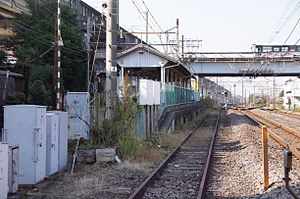- Tōbu Kumagaya Line
-
Tōbu Kumagaya Line 
Disused track of the former Tobu Kumagaya Line at Kami-Kumagaya Station, November 2011Overview Type Heavy rail Locale Saitama Prefecture Termini Saitama
MenumaStations 4 Operation Opened 1943 Closed 1983 Owner Tobu Railway Depot(s) None Rolling stock Tōbu KiHa 2000 series Technical Line length 10.1 km (6.3 mi) Track gauge 1,067 mm (3 ft 6 in) Electrification Not electrified The Tōbu Kumagaya Line (東武熊谷線 Tōbu Kumagaya-sen) was a 10.1 km single-track line operated by Tobu Railway, which ran from Kumagaya to Menuma in Saitama Prefecture.[1]
Contents
History
Construction of the line was planned during the Pacific War to provide transportation for the military supply factories located in the area. It opened on 5 December 1943, although the shortage of materials during the war meant that the rails for the line had to be procured by singling the Tōbu Nikkō Line between Kassemba and Tōbu Nikkō Stations. The original plan to extend the line beyond Menuma over the Tone River to the freight terminal at Shin-Koizumi (on the now closed Sengokugashi Freight Line extending from the Tōbu Koizumi Line at Nishi-Koizumi) was cancelled following the end of the war.[1]
The line was not linked to any other Tōbu lines, and remained unprofitable. It was finally closed on 31 May 1983.[1]
Some of the former Kumagaya Line track remains in situ between Kumagaya and Kami-Kumagaya on the Chichibu Main Line, as does one of the concrete piers for the planned Tone River bridge, on the Gunma Prefecture side of the river.[2]
Stations
- Kumagaya
- Kami-Kumagaya
- Ōhata
- Menuma
Source: [2]
Rolling stock
The line was initially operated using Class B2 (ex-JNR Class 5300) Beyer Peacock-built steam locomotives (numbers 27 and 28, ex-JNR 5312 and 5313) hauling former DeHa 1 electric cars converted to non-powered passenger coaches.[2] New KiHa 2000 series diesel railcars were introduced from 1954.[1]
References
- ^ a b c d 歴史でめぐる鉄道全路線NO.5 東武鉄道2 (Railway Line History No. 5: Tobu Railway 2). Japan: Asahi Shimbun Publications Inc. September 2010. ISBN 978-4-02-340135-8.
- ^ a b c "東武鉄道熊谷線と那須電気軌道 [Tobu Kumagaya Line and Nasu Tramway]". Japan Railfan Magazine (Japan: Kōyūsha Co., Ltd.) 50 (590): p.128–135. June 2010.
Tōbu lines Tōbu Main lines Tōbu Tōjō lines Closed lines Ikaho Tramway • Keishi Line • Kumagaya Line • Nikkō Tramway • Ōya Line • Yaita LineRelated lines Major Stations Categories:- Lines of Tobu Railway
- Rail transport in Saitama Prefecture
- 1067 mm gauge railways in Japan
Wikimedia Foundation. 2010.

